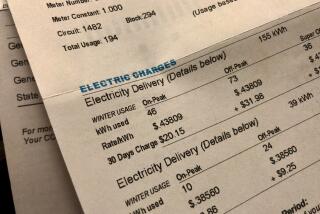Utility Bills Fast Becoming Utility Billboards : Consumer Groups Struggle to End Ban on Inserted Messages
SAN DIEGO — Utility managers have escalated their efforts to turn back billing insert programs that allow consumer groups to insert messages that bluntly ask disgruntled utility customers to band together.
Invariably, utility managers consider such billing inserts to be filled with half-truths and misleading statements. The eight Utility Consumers Action Network messages that San Diego Gas & Electric carried during 1984 and 1985 as part of a California Public Utilities Commission experiment provide an example of the disagreements that arise.
“None of UCAN’s eight inserts ended up being acceptable to us,” said Walter Scott, an SDG&E; consumer affairs administrator who acted as the utility’s liaison with UCAN during the insert experiment. “They were 0 for 8. I don’t think UCAN did anything (in their inserts) that wasn’t misleading.”
Although UCAN Executive Director Michael Shames acknowledged that his organization’s messages were designed to be “eyecatching,” he denied that they were misleading.
He countered that SDG&E; inserts--which are financed by utility shareholders--”are misleading. Their most recent insert suggests that SDG&E;’s cost-cutting caused lower rates . . . when in reality if SDG&E; had gotten their way (during recent PUC rate hearings), they would have increased rates.”
Rocked by Ruling
San Diego-based UCAN--which used the inexpensive and cost-effective inserts to build its membership to 80,000 SDG&E; customers--and other such consumer groups were rocked last month by a U.S. Supreme Court ruling.
The court declared unconstitutional a state PUC insert program giving San Francisco-based Toward Utility Rate Normalization (TURN) access to Pacific Gas & Electric’s billing envelopes. The state had failed to show compelling enough reasons for the inclusion of the messages in PG&E;’s bills, the court ruled, and the PUC program had wrongfully forced the utility to carry them.
The decision heartened utilities that have initiated anti-insert lawsuits in Oregon, New York, Wisconsin and Illinois, where insert programs were either operating or being considered.
UCAN, which lost access to the envelopes last year pending the outcome of the Supreme Court ruling, has learned how expensive it can be to attract new members without access to SDG&E; billing envelopes.
“There’s no question that our fund-raising costs will rise dramatically,” Shames acknowledged. The group has been relying on a costly direct-mail campaign and expensive neighborhood canvassing to eliminate a deficit which, when recent attorney fees are included, has grown to $23,500.
State Will Pay Group
That deficit, largely due to legal costs associated with several recent rate case challenges, likely will be erased when California pays the organization $95,000 in intervenor fees stemming from those cases.
“Things will get tougher, but our board of directors has no intention of giving up the ship,” Shames said. He remains confident that the PUC will act favorably upon UCAN’s request that the commissioners fashion a new regulatory insert order that would pass guidelines suggested in the Supreme Court’s ruling.
Shames and Kathleen O’Reilly, director of the Wisconsin Citizen Utility Board, believe that their organizations are strong enough to survive without inserts. The future is dimmer, however, for several fledgling citizen utility boards created by regulators, legislators or through a popular vote.
The U.S. Public Interest Research Group, which has served as a clearinghouse for state CUB organizing efforts, believes that “it’s still a little early to determine what the court decision means,” according to spokesman Tom Tobin.
However, Tobin argued that although the decision “seemed to be quite clear that a PUC can’t compel a utility to carry the message of a third party,” there are important distinctions between the insert program that PG&E; successfully challenged and CUBs that have gained regulatory or legislative insert approval.
“It’s going to be up to the courts across the country to determine how great those distinctions are,” Tobin said.
Only Effective Way
In light of the Supreme Court decision, Tobin said, observers have asked why CUBs “shouldn’t just go out and organize a not-for-profit group like others have done. But we argue that inserts are the only economical and effective way to organize ratepayers because the cost of utility intervention is so high.”
“You can’t be effective without a strong membership base,” suggested Amy Keiter, the sole staff member of the Oregon Citizens Utility Board, which was formed by state initiative in 1984. “You need that base to be able to hire the experts and keep up the same quality that the utilities present.”
The Oregon CUB, which has been denied access to inserts during a utility-initiated court challenge, has struggled to attract just over 5,000 members--far less, Keiter acknowledged, than likely would have joined through an insert program.
“The Supreme Court took away what could be a very cost-effective tool, but it doesn’t change what we’re trying to do,” Keiter said. “We’re just going to have to take longer and face more of a struggle.”
In New York, however, the court decision could kill a CUB that the Public Service Commission recently created. When commissioners created the CUB in 1984, they included a sunset clause that required the organization to “attract 50,000 members within the next couple of years or be disbanded,” said Tim Massad, an attorney who is acting as president of the fledgling organization.
“CUBs can’t exist without the inserts,” Massad said, adding that CUB proponents now must work with regulators to fashion insert programs that will pass Supreme Court muster.
Consumers Would Suffer
“If we can’t (design programs which will survive court challenges) and CUBs go out of business, then consumers will have suffered a very big loss for the sake of a very minor gain to utilities,” Massad said. “What’s really at stake is letting consumers get together at their own expense to try and improve their services.”
The court decision has also stalled CUB proponents who have been pushing regulators and legislators to extend insert programs to include citizen boards that would monitor other industries.
“Insurance and banking have been the most frequently talked about industries,” said Tobin, whose organization has created model legislation for establishing CUBs. “A bill was introduced in the Maryland Legislature recently to establish a public group to (provide direct public involvement in) banking issues.”
More to Read
Inside the business of entertainment
The Wide Shot brings you news, analysis and insights on everything from streaming wars to production — and what it all means for the future.
You may occasionally receive promotional content from the Los Angeles Times.










